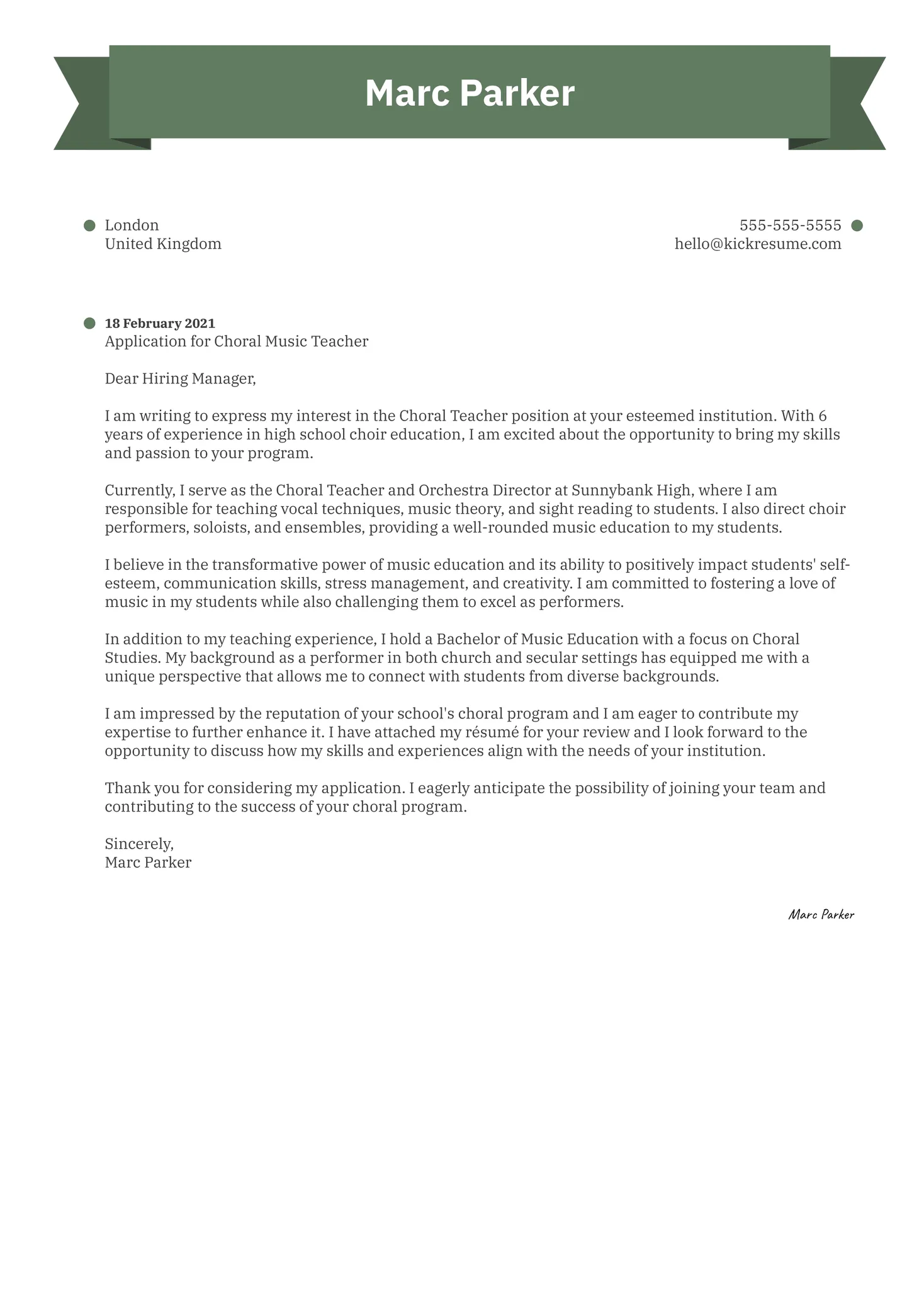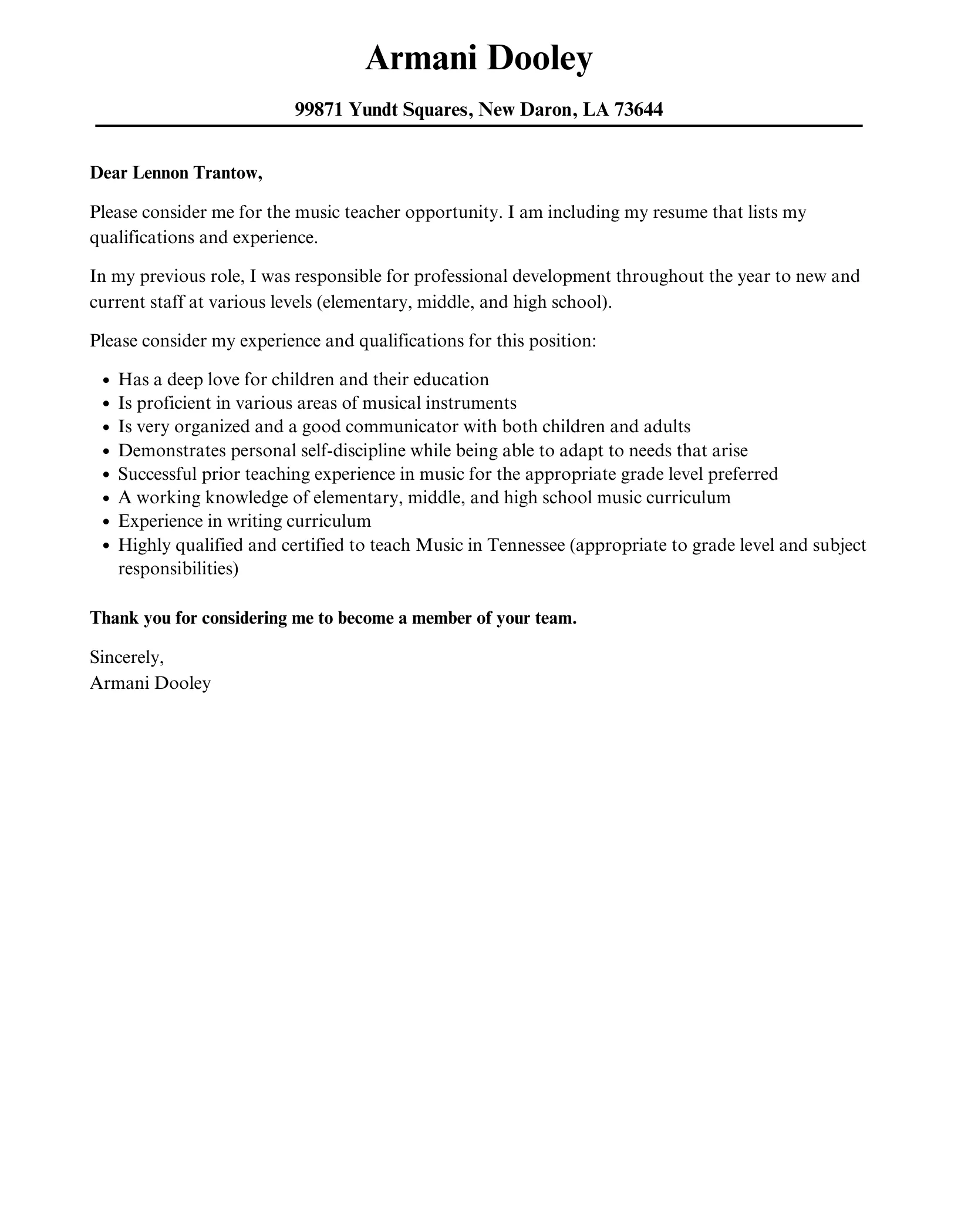Highlighting Your Passion for Music Education
A compelling cover letter for a music education position is your first opportunity to make a positive impression. It’s where you can showcase your enthusiasm and love for music and teaching. Your passion should be immediately apparent, setting the tone for the rest of the letter. This means going beyond simply stating your interest; it means articulating why you’re drawn to music education. Do you believe in the transformative power of music? Are you excited about inspiring the next generation of musicians? These are the kinds of sentiments that resonate with hiring committees. Start by detailing what specifically excites you about teaching music, whether it’s fostering creativity, building teamwork, or instilling a lifelong appreciation for the arts. Don’t be afraid to inject your unique personality and teaching philosophy into your opening statement. Show the hiring manager that you are not simply applying for a job, but that you are motivated to share your love of music with young people.
Showcasing Your Qualifications and Skills
While your passion is vital, your qualifications and skills form the foundation of your application. This section should provide a clear and concise overview of your academic background, teaching experience, and any relevant certifications or training. Consider the specific requirements of the job posting and tailor your presentation accordingly. If the position emphasizes choral direction, highlight your experience in that area; if it requires proficiency in a particular instrument, make sure to showcase your expertise. Be sure to quantify your accomplishments whenever possible, for instance, by mentioning the number of students you’ve taught, the success of your ensembles in competitions, or any curriculum you have developed. The goal is to demonstrate that you possess the necessary skills and experience to excel in the role. Think about providing metrics, for example, how many students improved their sight-reading skills by X% or the number of performances you’ve organized. Make it easy for the hiring manager to see how your qualifications directly align with the needs of the position.
Music Education Background

Detail your academic journey. Mention your degrees, certifications, and any specialized training you’ve received. Highlight relevant coursework, such as music theory, pedagogy, or music history. Include any honors, awards, or scholarships you received. If you have a Master’s or PhD, make sure it’s clear and concisely stated. Also, if you have specific pedagogical training like Orff Schulwerk or Kodaly, be certain to include that information as these qualifications are highly sought after and can differentiate your application. If you’ve taken any specialized courses in music technology or assistive music technologies, mention them. Provide details about the institutions you attended and the dates of your graduation to paint a complete picture of your education. If you have completed student teaching, describe where and what grade level. Remember, your music education background is the foundation for your success.
Relevant Skills
List out all the skills that you have to offer. Your resume probably includes a list of skills as well, so this is a great chance to expand on your skills. Discuss your proficiency in various musical instruments, your knowledge of music theory and history, your ability to read and write music, and your experience with music technology software. Showcase your ability to teach diverse learning styles and manage a classroom effectively. Highlight your communication, organization, and collaboration skills. If you have experience with specific software like Finale, Sibelius or Ableton, mention them here. Furthermore, show that you can cater to students with special needs and how you modify lesson plans to accommodate a variety of learning methods. Finally, if you have experience in music performance or conducting, make sure to mention that as well. Show your ability to think outside the box to get students involved in music.
Tailoring Your Cover Letter to the Job
Generic cover letters rarely impress. To truly stand out, personalize your letter for each specific job application. This involves meticulous research and a thoughtful approach to showcasing how your skills and experience align with the school or institution’s needs. Demonstrate that you have taken the time to understand the role, the school’s values, and the specific requirements outlined in the job description. By aligning your letter to the role, you demonstrate that you have what it takes to fill the position. Tailoring your cover letter is essential.
Researching the School or Institution

Thoroughly research the school or institution to understand its mission, values, and music program. Visit their website, read their mission statement, and explore any information about the music department. Look for details about the existing music curriculum, the instruments offered, and any extracurricular activities. Consider the demographic of the students and the community the school serves. If the school is known for a particular teaching method, such as the Kodaly method or Orff Schulwerk, highlight any experience you have with that method. Understanding the school’s specific needs will help you tailor your cover letter to address their requirements. Take the time to do your homework.
Matching Skills and Experience
Carefully review the job description and identify the key skills and qualifications the employer is seeking. Make a list of these requirements and then align your experience and skills to these needs. Provide specific examples of how you have demonstrated these skills in previous roles. For instance, if the job description calls for experience in conducting a choir, provide details about your choral conducting experience, the size of the choirs you have led, and any achievements your choirs have attained. Use the same keywords and phrases from the job description in your cover letter, demonstrating a clear understanding of the requirements. Your cover letter needs to be a narrative of the skills you have to offer and your ability to address all of the expectations of the role. Directly address the job description and explain how your skills fit.
Formatting and Tone
The formatting and tone of your cover letter are critical to making a positive impression. Your letter should be professional, well-organized, and easy to read. A polished cover letter indicates attention to detail and professionalism. Choose a professional font, such as Times New Roman, Arial, or Calibri. Ensure that your letter is free of grammatical errors, typos, and formatting inconsistencies. The tone of your cover letter should be enthusiastic, engaging, and reflective of your personality and teaching style. It should also be respectful and reflect your understanding of the role and the institution. Avoid jargon and use clear, concise language. Maintain a professional and friendly attitude throughout the letter.
Professional Formatting

Choose a standard professional font like Times New Roman, Arial, or Calibri in a size between 10 and 12 points. Use a clear and consistent font throughout the entire document. Keep your margins at 1 inch on all sides. This provides ample white space and makes the document easy to read. Include your contact information at the top of the letter, including your name, address, phone number, and email address. This makes it easy for the hiring manager to contact you. Use a proper business letter format, including a date, the hiring manager’s name and title (if known), the school or institution’s address, and a formal closing. Use short paragraphs and bullet points to break up text and improve readability. Keep the letter to one page in length, and remember to save it as a PDF file to preserve the formatting. Make sure your formatting is consistent throughout the entire cover letter.
Enthusiastic and Engaging Tone
Your cover letter should reflect your personality and teaching style. Write in a positive and enthusiastic tone, demonstrating your excitement about the music education opportunity. Use strong verbs and action words to describe your skills and accomplishments. For example, instead of saying “I taught music,” say “I developed and implemented a comprehensive music curriculum.” Use the job description as a guide to determine the tone. For example, if the job description uses words such as collaborative, inclusive, or creative, use those same words in your cover letter. Demonstrate your understanding of the school’s values and mission. This could include mentioning your commitment to fostering a positive and inclusive learning environment for all students. Finish with a call to action, expressing your eagerness for an interview and detailing how you plan to take your next steps. Always stay positive and professional.
Proofreading and Editing
Before submitting your cover letter, meticulously proofread and edit it for any errors. Errors in your cover letter can immediately disqualify you. Grammatical errors, typos, or formatting inconsistencies can undermine your credibility. Therefore, it’s essential to take the time to review your letter carefully. Start by reading your cover letter aloud, which can help you catch errors that you might miss when reading silently. Make sure your letter flows logically, with clear and concise language. Ensure that your tone is appropriate for the position and the institution. A good rule of thumb is to set your cover letter aside for a day or two and then review it with a fresh perspective. Ideally, ask a trusted colleague, friend, or mentor to review your cover letter and provide feedback. Proofreading is essential for success.
In conclusion, a compelling music education cover letter can significantly increase your chances of landing an interview. By highlighting your passion, showcasing your qualifications, tailoring your letter, and ensuring a professional tone, you will impress hiring managers. Remember to focus on the specific needs of each job, demonstrate your skills, and always proofread carefully. By following these tips, you’ll be well on your way to securing your dream music education position. Good luck! A well-written cover letter can unlock many opportunities.
